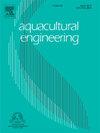Design and testing of a fully automatic aquatic plant combing machine for Eriocheir sinensis farming
IF 3.6
2区 农林科学
Q2 AGRICULTURAL ENGINEERING
引用次数: 0
Abstract
Aquatic plant cleaning in Eriocheir sinensis farming currently relies heavily on manual methods, which are labor-intensive and inefficient. To address this issue, this study explores fully automated aquatic plant raking technology. Considering the physical characteristics of aquatic plant in Eriocheir sinensis farming, a novel approach using torsion spring hooks instead of traditional cutting blades for plant removal is proposed. A aquatic plant combing mechanism and a water depth adjustment mechanism were designed to enhance functionality. Furthermore, a multi-drawer-type aquatic plant spreading method was introduced, along with an automatic mechanism for uniformly spreading aquatic plant. Adams simulation software was employed to analyze the movement of the multi-drawer silo under various working conditions, determining the minimum damping force required for the damping mechanism in extreme scenarios. A prototype was subsequently fabricated and tested. Experimental results confirmed that the combing mechanism operated smoothly without jamming, meeting all design specifications. The prototype demonstrated stable underwater performance, reliable depth adjustment, and high cleaning efficiency, fully aligning with the intended design objectives.
中华绒螯蟹养殖全自动水生植物精梳机的设计与试验
目前中华绒螯蟹养殖中水生植物的清洗主要依靠人工方法,这是劳动密集型的,效率低下。为了解决这一问题,本研究探索了全自动水生植物耙取技术。针对中华梭子蟹养殖中水生植物的物理特性,提出了一种利用扭转弹簧钩代替传统切割刀片进行植物去除的新方法。为增强功能,设计了水生植物梳理机构和水深调节机构。此外,还介绍了一种多抽屉式水生植物铺展方法,以及一种均匀铺展水生植物的自动机构。采用Adams仿真软件对多抽屉筒仓在各种工况下的运动进行分析,确定极端工况下阻尼机构所需的最小阻尼力。随后制造了一个原型并进行了测试。实验结果表明,该精梳机构运行平稳,无卡壳现象,符合设计要求。样机的水下性能稳定,深度调节可靠,清洁效率高,完全符合设计目标。
本文章由计算机程序翻译,如有差异,请以英文原文为准。
求助全文
约1分钟内获得全文
求助全文
来源期刊

Aquacultural Engineering
农林科学-农业工程
CiteScore
8.60
自引率
10.00%
发文量
63
审稿时长
>24 weeks
期刊介绍:
Aquacultural Engineering is concerned with the design and development of effective aquacultural systems for marine and freshwater facilities. The journal aims to apply the knowledge gained from basic research which potentially can be translated into commercial operations.
Problems of scale-up and application of research data involve many parameters, both physical and biological, making it difficult to anticipate the interaction between the unit processes and the cultured animals. Aquacultural Engineering aims to develop this bioengineering interface for aquaculture and welcomes contributions in the following areas:
– Engineering and design of aquaculture facilities
– Engineering-based research studies
– Construction experience and techniques
– In-service experience, commissioning, operation
– Materials selection and their uses
– Quantification of biological data and constraints
 求助内容:
求助内容: 应助结果提醒方式:
应助结果提醒方式:


